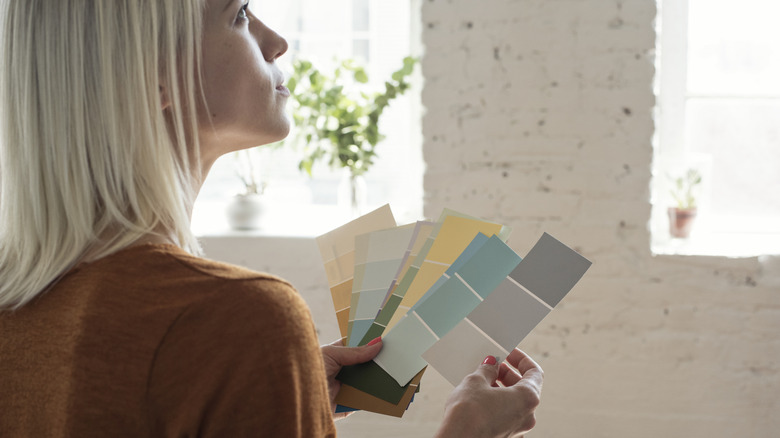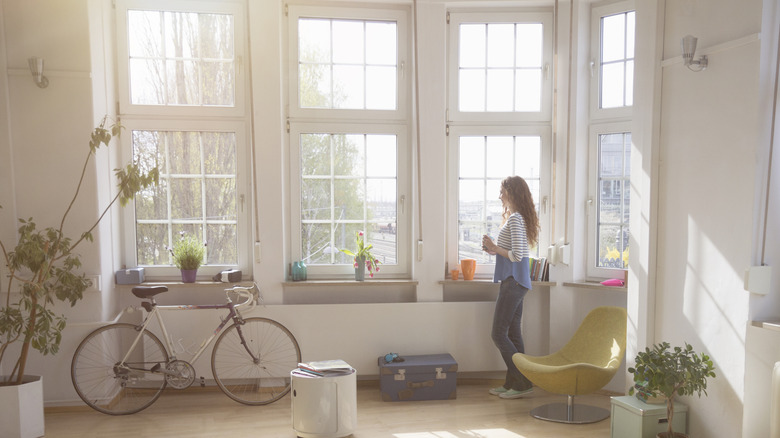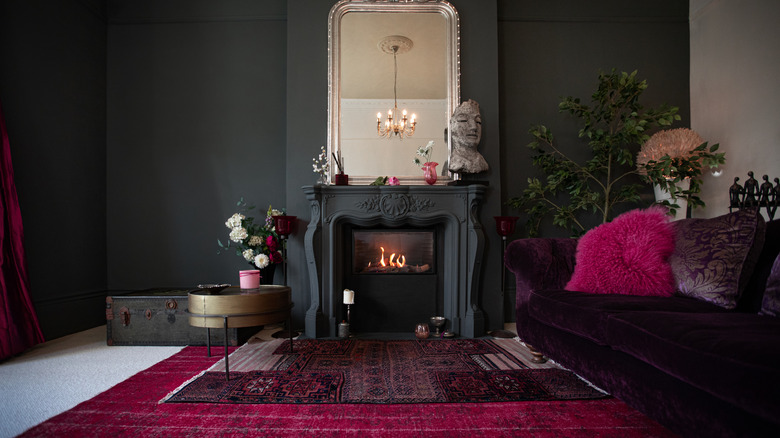Why You Should Consider What Comes Through Your Window When Choosing A Paint Color
Have you ever spent weeks picking out the perfect shade of paint, only for it to feel all wrong in your room? Maybe it's way darker than you expected, or much too light. Perhaps the sheen doesn't feel right for the space, or the undertones look totally different than the tiny swatch you spent hours studying. We've all been there. Getting the color wrong is just one of the mistakes everyone makes when buying paint. Since repainting can be a costly and time-consuming venture, it's better to get it right the first time. According to design historian Sarah Bilotta, the orientation and light conditions of your room are important factors you should consider when choosing a paint color.
"I think understanding the orientation of a room can be an important component to choosing a paint color," Bilotta said during her exclusive interview with House Digest, "but it also depends what time of day you anticipate spending most of your time in that room." If you're not actually spending your time in the room, at the right time, your paint color choices won't be as impactful. "You may not reap the benefits of seeing a golden wheat-hued wall emphasized by the golden light of sunset if you do not spend any time in the room at golden hour," Bilotta explained. "Additionally, it's key to consider that the period during which certain light conditions appear in a room will change throughout the year as days get longer or shorter," she added.
Which color is best for north, south, east, or west
During her exclusive interview with House Digest, Sarah Bilotta offered several paint preferences and suggestions that depend on which direction your room faces and what feeling you're trying to achieve. Can't decide on a paint color to use in your home? Try the compass on your phone to determine the direction of your room prior to selecting a paint color scheme. Stand facing the largest window to determine if you're working with north, south, east, or west-facing light.
"If you want your northerly-facing room to feel warm and cozy, use an extra-saturated warm paint tone to offset the generally cool and consistent tones of light from the north," Bilotta suggested. To achieve the opposite effect, she advised using colors like Ballet White by Benjamin Moore to make a room look expansive and cool. Bilotta says a south-facing room gives you more options. "A consistent, warm light means you can use cool colors without making the space look clinical and cold," she explained. "You can also play with dark, saturated colors that will be evenly lit throughout the day."
According to Bilotta, when your room faces east or west, it's wise to warm things up. "I prefer to go with lighter tones in east-facing rooms, as you can make the most of the day," she explained, adding that warm hues enhance a room even during cold winters. "A room facing west can also be quite versatile," Bilotta added. She said she likes to accentuate the golden hour found in west-facing rooms with deep shades like Renaissance Gold by Benjamin Moore.
Consider other elements and artificial lighting before picking your paint color
During her exclusive interview with House Digest, Sarah Bilotta told us that along with the walls, your carpeting, flooring, and major accent pieces "write the color story" in the most beautiful rooms. "These are the statement-makers in the space, so you can't disregard them," she said. "The direction of the room should not be the only factor which determines your paint color," Bilotta advised us. "The other accents in the room, the wall decor, and the function of the room should play a greater role," she said.
When it comes to choosing the perfect paint color, Bilotta recommends painting swatches all over your room, observing them in a variety of natural and artificial lighting. She also said you should make sure you still like the color at night. "For example, you may be disappointed to use a deep, rich eggplant paint in an east-facing living room, only to find that you spend the best daylight hours in your office, and by the time you get to sit down in that room to relax, the purple hues are cast in shadow," Bilotta cautioned. "But that shouldn't stop you from using deep hues in east-facing rooms," she added. In those cases, the design historian suggests adding artificial lighting that provides enough ambient light to achieve your intended color. Don't forget to consider the lighting temperature, too, which is one of the best tricks for getting good lighting in every room in your home.


